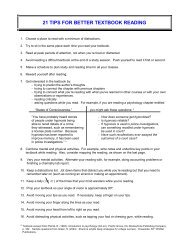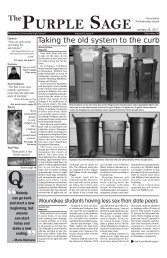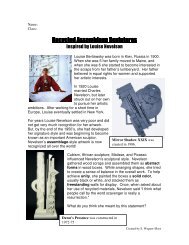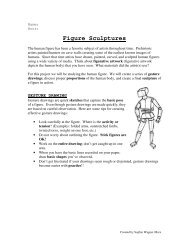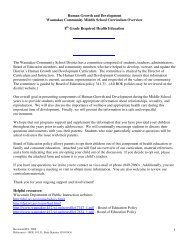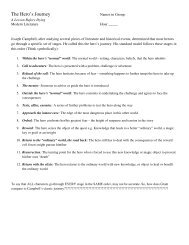FACTORS There are hundreds of reasons why physical activity is ...
FACTORS There are hundreds of reasons why physical activity is ...
FACTORS There are hundreds of reasons why physical activity is ...
Create successful ePaper yourself
Turn your PDF publications into a flip-book with our unique Google optimized e-Paper software.
• HEALTH<br />
et <strong>of</strong>f your rear and<br />
get some exerc<strong>is</strong>e!"<br />
How many times<br />
have you heard that<br />
from one <strong>of</strong> your<br />
p<strong>are</strong>nts? Like it or not, it's excellent<br />
advice—even more than your<br />
mom or dad probably knows.<br />
Regular exerc<strong>is</strong>e helps you stay<br />
fit and maintain a healthy weight.<br />
That much <strong>is</strong> certain. Recently,<br />
however, scient<strong>is</strong>ts have d<strong>is</strong>covered<br />
that working muscles seem<br />
to "talk" directly to other parts <strong>of</strong><br />
the body. What the muscles <strong>are</strong><br />
saying may be very important to<br />
your health.<br />
When muscles work, they somehow<br />
communicate with the brain,<br />
liver, and other organs. Until<br />
recently, scient<strong>is</strong>ts weren't sure<br />
how muscles sent those messages,<br />
"Researchers for many decades<br />
have been searching for<br />
an 'exerc<strong>is</strong>e factor,'" says<br />
Bente Klarlund Pedersen,<br />
a pr<strong>of</strong>essor <strong>of</strong> medicine<br />
at the University <strong>of</strong><br />
Copenhagen, Denmark,<br />
Now it seems she's found just<br />
such an ex factor—and not just<br />
one, but <strong>hundreds</strong>.<br />
SLIGHT SWELLING<br />
Lack <strong>of</strong> exerc<strong>is</strong>e <strong>is</strong> linked to<br />
all sorts <strong>of</strong> health problems.<br />
It increases the r<strong>is</strong>k <strong>of</strong> conditions<br />
such as depression, osteoporos<strong>is</strong><br />
(thinning and weakening <strong>of</strong> the<br />
bones), dementia (loss <strong>of</strong> mental<br />
abilities), heart d<strong>is</strong>ease, some<br />
cancers, and type 2 diabetes.<br />
<strong>FACTORS</strong><br />
<strong>There</strong> <strong>are</strong> <strong>hundreds</strong> <strong>of</strong><br />
<strong>reasons</strong> <strong>why</strong> <strong>physical</strong> <strong>activity</strong><br />
<strong>is</strong> important to good health.<br />
All d<strong>is</strong>eases linked to<br />
lack <strong>of</strong> exerc<strong>is</strong>e have<br />
something in common:<br />
chronic inflammation.<br />
Inflammation <strong>is</strong> a swelling<br />
and redness in the<br />
body's t<strong>is</strong>sues that <strong>is</strong> usually<br />
brought about by an injury or an<br />
infection—usually a short-term<br />
reaction. Constant, low levels <strong>of</strong><br />
inflammation that occur throughout<br />
the body <strong>are</strong> tied to more serious<br />
problems, including dementia, heart<br />
d<strong>is</strong>ease, and diabetes—virtually all<br />
the d<strong>is</strong>eases that <strong>are</strong> linked to lack<br />
<strong>of</strong> exerc<strong>is</strong>e.<br />
Skeletal muscles <strong>are</strong> attached to<br />
the skeleton. They're also called<br />
voluntary muscles because you<br />
can consciously decide to make<br />
them contract or relax.
Low-level inflammation <strong>is</strong><br />
marked by an increase in certain<br />
immune cells, called cytokines, in<br />
the blood. Pedersen was studying<br />
cytokines when she d<strong>is</strong>covered<br />
that one <strong>of</strong> them—interleukin 6<br />
(JL-6)—"was present in the blood<br />
during exerc<strong>is</strong>e in huge amounts,"<br />
she says.<br />
When you're at rest, your levels<br />
<strong>of</strong> IL-6 <strong>are</strong> very low. As you work<br />
your skeletal muscles, however,<br />
the amount <strong>of</strong> IL-6 in the blood<br />
shoots up dramatically. Skeletal<br />
muscles <strong>are</strong> the muscles that<br />
we control voluntarily to move<br />
our bodies.<br />
At first, the d<strong>is</strong>covery puzzled<br />
Pedersen. When IL-6 <strong>is</strong> produced<br />
by immune cells, it causes inflammation.<br />
When the muscles make<br />
IL-6, it reduces inflammation.<br />
Why might that be? Exerc<strong>is</strong>e seems<br />
to hold back other chemicals that<br />
normally woric hand in hand with<br />
IL-6 to cause inflammation.<br />
To learn more, Pedersen created<br />
a breed <strong>of</strong> mice whose muscles<br />
did not release IL-6 when they<br />
exerc<strong>is</strong>ed. The results were<br />
dramatic. "Mice that did not<br />
produce IL-6 became obese and<br />
developed insulin res<strong>is</strong>tance"<br />
she says. Insulin res<strong>is</strong>tance occurs<br />
when the body's cells stop reacting<br />
to insulin, a hormone that regulates<br />
blood sugar. It <strong>is</strong> an early<br />
warning sign <strong>of</strong> type 2 diabetes.<br />
In other words, IL-6 appe<strong>are</strong>d to<br />
be the exerc<strong>is</strong>e factor that Pedersen<br />
was looking for.<br />
MYSTERIOUS<br />
MOLECULES<br />
IL-6 was just the start. Once she<br />
started looking more closely,<br />
Pedersen realized that working<br />
muscles produce many different<br />
compounds. She called those<br />
compounds myokines, and she's<br />
identified a whopping 600 <strong>of</strong><br />
them so far.<br />
"Most <strong>of</strong> the 600 myokines <strong>are</strong><br />
totally unknown, and we have<br />
absolutely no clue about their role,"<br />
Pedersen says. It's clear they ex<strong>is</strong>t.<br />
High in Fiber<br />
What <strong>are</strong> muscles made <strong>of</strong>?<br />
My<strong>of</strong>ibrii<br />
The body's skeletal musdes contain <strong>hundreds</strong> or thousands <strong>of</strong> long, thin, cylindrical fibers that <strong>are</strong> bundled<br />
in groups called fascicles. Each fiber <strong>is</strong> composed <strong>of</strong> smaller cylindrical my<strong>of</strong>ibrils. When a muscle contracts,<br />
chemical reactions occur in the my<strong>of</strong>ibrils, producing compounds called myokines. Researchers have linked<br />
some myokines to health benefits such as weight control and the formation <strong>of</strong> new blood vessels.<br />
she adds, "but we don't know what<br />
they're doing."<br />
Slowly, she and her colleagues<br />
<strong>are</strong> learning how myokines work.<br />
They're all very different from one<br />
another, she says, and seem to play<br />
many different roles throughout<br />
the body.<br />
• In addition to its connection<br />
to preventing obesity and insulin<br />
res<strong>is</strong>tance, IL-6 communicates<br />
with cells in the liver.<br />
• A myokine called IL-8 helps<br />
the body form new capillaries,<br />
the body's smallest blood vessels.<br />
• IL-15 encourages muscle<br />
growth and helps prevent the<br />
buildup <strong>of</strong> abdominal fat—fat in<br />
the belly. Abdominal fat <strong>is</strong> more<br />
harmful to overall health than fat<br />
elsewhere in the body.<br />
Both mice were fed a high-fat diet. The top<br />
one gained weight. The bottom one did not,<br />
because its musdes had been genetically<br />
altered to make more myokines.<br />
That's just a handful <strong>of</strong> myokines<br />
that have been studied<br />
so far. Hundreds more <strong>are</strong> a<br />
mystery—for now. Pedersen and<br />
her colleagues <strong>are</strong> eager to understand<br />
how each muscle-made<br />
molecule affects the body, from<br />
head to toe. Some myokines, she<br />
suspects, might even have an anticancer<br />
effect.<br />
MUSCLE MEDICINE<br />
The d<strong>is</strong>covery <strong>of</strong> myokines <strong>is</strong> a<br />
starting place, Pedersen says,<br />
"for understanding how exerc<strong>is</strong>e<br />
can protect against d<strong>is</strong>eases." It's<br />
too soon to know whether myokines<br />
might be harnessed to prevent or<br />
cure illnesses such as diabetes or<br />
cancer. But it's an intriguing idea.<br />
One day, Pedersen says, it might<br />
be possible to prescribe a medication<br />
that triggers patients' muscles<br />
to produce more myokines. Such<br />
drugs could benefit people who<br />
<strong>are</strong> unable to exerc<strong>is</strong>e on their<br />
own—^people who <strong>are</strong> paralyzed<br />
or recovering from serious injuries<br />
or illnesses, for example.<br />
For now, that's just a dream. Yet<br />
even as scient<strong>is</strong>ts <strong>are</strong> working to<br />
understand what each myokine<br />
does, one thing seems clear: <strong>There</strong><br />
<strong>are</strong> at least 600 good <strong>reasons</strong> to<br />
get <strong>of</strong>f the couch and move your<br />
muscles! CS<br />
10101 Clodwlitfraffltopik|ht:CbiHLiiiiwCaitit<strong>of</strong>lnfbmautl«itMeuMlwwSlwnmtock;CMtre<strong>of</strong>lnfbnim«^ Dacambcr 10,2010 Currant Scicnc« g
Copyright <strong>of</strong> Current Science <strong>is</strong> the property <strong>of</strong> Weekly Reader Corporation and its content may not be copied<br />
or emailed to multiple sites or posted to a l<strong>is</strong>tserv without the copyright holder's express written perm<strong>is</strong>sion.<br />
However, users may print, download, or email articles for individual use.



